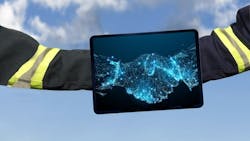Crisis response for manufacturing teams in the process industries
The strongest and richest form of human communication is face to face. Until the COVID-19 pandemic occurred, most people took this form of communication for granted. Normal communications among manufacturing teams have been upended with the need for social distancing and shift changes.
While companies have contingency plans for a variety of circumstances, hardly any contemplated a scenario like COVID-19. Face-to-face meetings, shift handovers, continuous improvement meetings and meetings on the shop floor — all had to be eliminated and this meant everyone would need to quickly adjust and adapt to a new “normal.”
This new normal needs to involve the digitization of communication processes. Although the pandemic may be an extreme case, any crisis requires resilience, agility and engagement. Artificial intelligence (AI) is penetrating deeper into and across our businesses and its operations. In the process industries, AI will only thrive if human intelligence is incorporated as part of the solution, especially for situations where hazardous and complex processes are operated by highly skilled and experienced experts.
The crisis response cycle
Three main considerations crucial to operating plants when responding to a crisis begin with:
- Production team’s agility: To keep the availability of shift teams and reduce the shift-to-shift contamination.
- Remote team and plant management: Enable plant managers and process engineers to work remotely yet effectively and efficiently.
- Extraordinary actions and contingency plans: Be prepared to downsize your production team and initiate critical actions.
Taking immediate actions are vital for the resolution of a crisis. Addressing these three considerations correctly will result in your plants operating with greater agility and establishing “Business Resilience."
Production team’s agility
Frontline personnel are the most important. We all learned about “social distancing” due to COVID-19 as the first and most effective action to reduce the spread of the virus and to reduce shift-to-shift contamination.
Since the process industries consists of many hazardous processes, many layers of protection depend on the cooperation between people. For example, the shift handover requires a conversation, many assessments dependent on interdisciplinary collaboration and the 4-eyes principle, which means that two people need to approve every important decision and action.
Reduce shift-to-shift contamination — replace face-to-face
The shift handover represents a very vulnerable point in plant operations. It relies on a combination of passing information in written and verbal form from one shift to the next — and comprises the combination of tasks recommended by industry experts. Verbal information exchange is best executed as a face-to-face meeting. This is why, in continuous processing plants, shifts typically overlap for 15-30 minutes to accommodate the need for verbal exchanges.
With the contagion rate of the COVID-19 virus, the time overlap could allow virus to contaminate other colleagues in any shift and hand-over meetings and why face-to-face communication must be replaced by a telephone or video conference call.
High-quality handover protocols use a management solution to provide a “virtual” handover to ensure the outgoing team has collected and handed over to the incoming team all necessary information before departing the control room. A 360-degree overview of all events and changes makes sure that all information known is captured and stored. It provides an audit trail and customizable forms for each operation.
Normally both shift supervisors meet at the same computer, which enables the outgoing person to more easily recognize any missing information that they then instantly fill in. Operating conditions during a pandemic means the outgoing shift will need to be better prepared than before.
Contingency procedures involve the following steps:
- The outgoing team shares the data and details any necessary information in writing.
- The outgoing team leaves the control room, performing any sanitation protocols that might exist before the incoming shift team enters the room.
- Both the outgoing and incoming shifts ensure there is no physical contact — ever.
- Synchronous verbal exchange takes place between the outgoing and incoming shifts, either by telephone or a video-conferencing solution.
During any verbal exchange, both shift supervisors should adhere to the same digital protocol — ensuring one source and version of the truth. This could be for each person his/her own tablet, or a notebook computer, or at the very least a printout.
Best practice setup
Beyond implementing communication protocols, a best practice would comprise the shift handover to occur in two completely segregated rooms that do not share ventilation systems.
Each room would contain desks and chairs, an office computer, two big screens and video conferencing capabilities. An appropriate handover management solution with structured protocols and procedures is crucial and described in the next three sections.
Prepare the shift protocol continuously
The process industries are unique in the complexity and diversity of their plants. Consequently, each shift organization looks slightly different — comprising locally different roles with specific responsibilities and accountabilities for board operators, outside operators and shift supervisors. Global unified responsibilities for HSE (Health Safety and Environment), Quality and GxP (Good Manufacturing Practices) are assigned to different managers.
Those on the shift are more likely to adopt a digital solution capable of structuring the information according to unique job roles. Enterprises need global standards and local adaptions to achieve high user acceptance and work effectively.
The person executing a certain task or making specific observations should use their company’s formalized digital forms whether an incident report, work permits or loss accounting. It should be standardized across the company so that everyone is following the same procedure and enforce a structured communication process.
Their shift management solution should enable decentralized data acquisition. Each person on a shift documents their information and enters their data themselves. This brings the single individual out of the shadows of the team and ensures accountability to the single person.
Each record should be available simultaneously on all devices to keep shift supervisors informed of all documentation. It enables supervisors to engage and add further comments. The frontline personnel are the eyes and the ears of the entire team. They can record videos and take photos and share with everyone — even the senior people at home.
It’s human nature to forget. So writing everything down immediately after anything has happened is essential. This way, if someone doesn’t show up for the next shift, perhaps because they’ve tested positive for COVID-19, then the essential information isn’t lost. When recording decisions, explain the “why,” which translates to the trigger point. Each person needs to be prepared before showing up to the next shift. It is key for others to get along without you and vice versa. This makes logging events, activities, observations and decisions very important.
Although distributed control systems and process historians are full of data, they often will not include communications of others, their insights, commentary or decision-making process.
Prepare the shift handover
A good shift handover needs preparation because the first 3-4 hours of operation are inherited from the shift before. As the shift comes close to ending, the shift supervisor needs to prepare for the handover.
Depending on the size of the shift teams, handovers should take place in parallel with board operators and shift supervisors. The scope and protocols of those handovers needs to be specified in a documented Standard Operating Procedure (SOP) managed by a shift management solution.
Examples of content for such handovers include, status of the safety-critical system (SCS) or life-critical systems, status of production, executed activities and ongoing work and priorities.
Execute an excellent shift handover
Outgoing shifts might be exhausted, and incoming shifts might be coming back after four days off and need to build their mental models in their minds.
Experts recommend that a handover needs to be both in writing and verbal. Many investigation reports about fatal accidents recommend this combination. In a pandemic, it's best to digitize the written record.
Talking remains important because synchronous communication allows for asking questions and ensures the message is conveyed. With social distancing, allow for an increase in the handover time by 5-10 minutes. Plan for the additional time required for disinfection activities and starting a remote video conference.
The remote handover conversation follows the structure of the handover protocol. Both the outgoing and the incoming shifts must see the same protocol on their devices. The outgoing person leads the handover conversation. They should explain line item by line item.
Relevant discussion points or events during a shift should be captured and notated as additional “information.” It’s important that the next shift and even senior people working remotely know what going on. It’s recommended to request digital signatures to ensure people have properly communicated.
Enable remote teams to work effectively
To reduce the contamination of the shift teams, managers and process engineers won’t be able to access the control rooms or plant buildings as often as they would normally.
Implement workplace flexibility. Work not needed to be conducted in the plant would be executed remotely. Create an infrastructure for the senior team that allows for remote access.
Frontline personnel need to share and allow access of their observations. Managers and engineers in their home offices need to be precise with all instructions so that even shift workers who did not participate can understand the tasks.
During a pandemic, a daily traffic light assessment should be added to your shift management software. It could be done each day and shared with everybody in the control room and off-site.
Digitize your logs and protocols
Working remotely should not result in significantly more emails for your production teams.
Switch from a page-based approach to a record-based approach, which can be implemented in your shift management software. Providing multi-dimensional views and connecting records across multiple shift reports is helpful. Indicating line items with a red flag will enable those line items to become part of production meeting reports.
It will also connect shift records with records in other mission critical systems like maintenance orders in SAP PM or IBM Maximo as well as losses from the historian like an OSIsoft PI. This record-based reporting principle allows sorting and ordering of key details at the push of a button. It easily enables a search in historical records, and helps build a knowledge base of the production plant.
Establish a communication platform and knowledge organization
This pandemic shows us how much we immediately benefit from the digitization of communication processes. Digitize meetings and instructions, and gather the feedback in a communication platform connects the people on- and off-site. Shift management solutions are known to replace five to 10 different tools and spreadsheets, as well as significantly reducing emails while keeping everyone informed and aligned.
Actions in pandemic times
Restrict access to control rooms. Establish a digital shift presence sheet for your crews. Be sure to write down all the people who have entered the control room such as a manager or a maintenance contractor who fixes an urgent problem. It will help trace who might have been exposed and infected in the event anyone tests positive for COVID-19.
Consider interruptions of your supply chain that could result in some manufacturers ordering raw material from secondary vendors and the need to note special instructions. Everything should be captured and shared in the shift management solution, including full digital signature tracing.
The challenges of COVID-19 requires much more agility from management, engineers and shift teams. But safety must be priority. There is no excuse to allow uncoordinated and undocumented changes, even in a crisis. Maintaining temporary instructions, such as those available in a comprehensive shift management solution will increase agility, deliver business resilience, ensure clear communications and ensure the company is safely organized.
Andreas Eschbach is the CEO of the plant process management software provider Eschbach.



